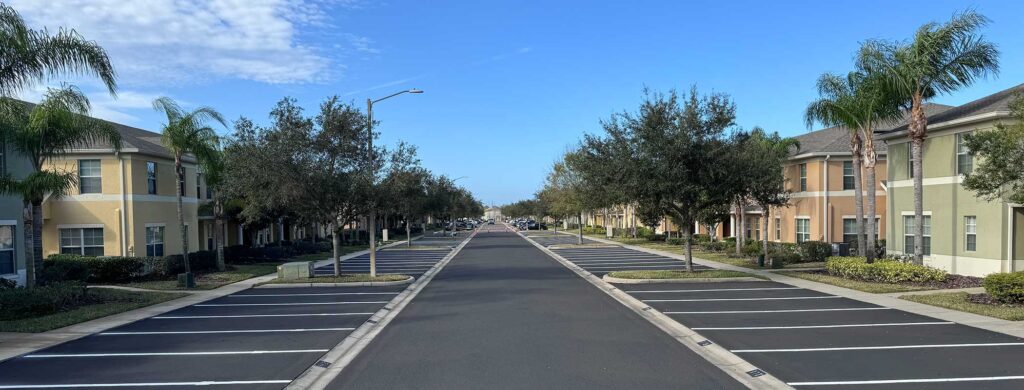Sustainable paving solutions minimize environmental impact while maximizing longevity and functionality. They utilize eco-friendly materials, construction techniques. Design principles to create durable and resilient surfaces that contribute to a healthier planet. In this comprehensive guide, we explore some of the most popular eco-friendly paving options and their benefits.
Permeable Pavement: Managing Stormwater Naturally
Permeable pavement is a groundbreaking solution that allows rainwater to infiltrate through the surface and into the underlying soil, replenishing groundwater supplies and reducing the risk of flooding. Unlike traditional pavement, which directs water into storm drains, permeable pavement mitigates stormwater runoff and promotes natural filtration, removing pollutants and contaminants before they reach water bodies.
Benefits of Permeable Pavement:
- Stormwater Management: Permeable pavement effectively manages stormwater by reducing runoff and preventing water from pooling on the surface. This helps alleviate strain on municipal drainage systems and minimizes the risk of urban flooding.
- Groundwater Recharge: By allowing rainwater to infiltrate into the soil, permeable pavement helps replenish groundwater supplies, maintain natural hydrological balance, and support healthy ecosystems.
- Pollution Reduction: The porous structure of permeable pavement acts as a natural filter, trapping sediments, debris, and pollutants from runoff water. This prevents harmful substances from entering waterways and protects water quality.
- Heat Island Mitigation: Permeable pavement helps mitigate the urban heat island effect by allowing water to evaporate from the surface, reducing temperature fluctuations, and improving overall microclimate conditions.
Eco-Friendly Materials: Paving the Way to Sustainability
In addition to permeable pavement, there are various eco-friendly materials used in sustainable paving solutions. These materials offer durability, functionality, and environmental benefits that make them ideal choices for green infrastructure projects.
Examples of Eco-Friendly Paving Materials:
- Recycled Asphalt: Recycled asphalt originates from reclaimed asphalt pavement (RAP) and recycled asphalt shingles (RAS). By reusing existing materials, recycled asphalt conserves natural resources and reduces the carbon footprint associated with asphalt production.
- Recycled Concrete: In paving applications, crushed concrete aggregates sourced from demolished structures can serve as a sustainable alternative to traditional aggregates. Recycling concrete reduces the demand for virgin materials and minimizes construction waste sent to landfills.
- Porous asphalt, like permeable pavement, allows water to infiltrate through the surface and into the subgrade. It helps manage stormwater runoff, prevent flooding, and reduce erosion while providing a durable and skid-resistant pavement surface.
- Rubber Pavers: Made from recycled rubber tires, rubber pavers offer a resilient and slip-resistant surface for pedestrian walkways, playgrounds, and outdoor recreational areas. Recycling rubber tires diverts waste from landfills and provides a durable alternative to conventional paving materials.
Incorporating sustainable paving solutions into infrastructure projects is essential for mitigating environmental impact and promoting long-term resilience. From permeable pavement to eco-friendly materials like recycled asphalt and rubber pavers, there are numerous options available to support environmentally conscious development and construction practices.
By choosing sustainable paving solutions, we can create healthier communities, reduce our carbon footprint, and preserve natural resources for future generations. Embracing innovation and adopting eco-friendly technologies pave the way to a more sustainable and resilient built environment.
Recycling Materials: Transforming Waste into Opportunity
Another sustainable paving option involves the use of recycled materials such as reclaimed asphalt pavement (RAP) and recycled concrete aggregate (RCA). By repurposing waste materials from demolition sites and road construction projects, we can minimize landfill waste and conserve valuable natural resources. Recycled materials offer comparable performance to virgin aggregates, while significantly reducing energy consumption and carbon emissions associated with production.
Benefits of Recycled Materials:
- Waste Reduction: Incorporating recycled materials into paving projects helps divert waste from landfills and reduces the need for virgin resources. This contributes to more sustainable waste management practices and minimizes environmental impact.
- Resource Conservation: By utilizing reclaimed asphalt and recycled concrete aggregate, we conserve natural resources such as aggregates and asphalt binder. This reduces the extraction of raw materials and preserves natural habitats and landscapes.
- Energy Savings: The production of recycled materials consumes less energy compared to manufacturing virgin aggregates and asphalt. This results in lower greenhouse gas emissions, which contributes to mitigating climate change and air pollution.
- Cost-Effectiveness: In many cases, recycled materials offer a cost-effective alternative to virgin aggregates and asphalt. Sourcing locally reduces transportation costs and supports the local economy.
Porous Asphalt and Concrete: Enhancing Water Management
Engineers design porous asphalt and concrete to allow water to pass through voids or pores in the surface, effectively managing stormwater runoff and reducing the strain on urban drainage systems. These permeable surfaces are highly durable and resistant to cracking, making them ideal for high-traffic areas such as parking lots, driveways, and pedestrian walkways. By promoting infiltration and groundwater recharge, porous pavements help sustain local ecosystems and mitigate the impacts of urbanization on water quality and quantity.
Advantages of Porous Pavements:
- Stormwater Management: Porous asphalt and concrete reduce surface runoff by allowing rainwater to infiltrate into the ground. This helps prevent flooding, erosion, and water pollution by filtering out pollutants and contaminants.
- Groundwater Recharge: Facilitate groundwater recharge, by replenishing aquifers and maintaining natural hydrological cycles. This supports healthy ecosystems and provides a sustainable source of water for vegetation and wildlife.
- Durability and Longevity: Despite their permeable nature, porous pavements are durable and resilient to heavy traffic and environmental stressors. They resist cracking and rutting, resulting in a longer service life and reduced maintenance requirements.
- Environmental Benefits: The use of porous asphalt and concrete contributes to the preservation of water resources, the reduction of the heat island effect, and the enhancement of urban biodiversity. These environmental benefits improve the quality of life for communities and promote sustainable urban development.
Incorporating recycled materials and porous pavements into paving projects offers significant environmental, economic, and social benefits. By embracing sustainable paving solutions, we can minimize waste generation, conserve natural resources, and mitigate the impacts of urbanization on water resources and ecosystems.
Through innovation and collaboration, we can create resilient and sustainable built environments that enhance the quality of life for present and future generations. Sustainable paving practices pave the way to a more sustainable and resilient future.
Green Paving: Blending Nature with Infrastructure
Green pavers combine the aesthetic appeal of traditional paving materials with the ecological benefits of green infrastructure. These innovative paving systems feature interlocking grids or panels filled with vegetation, creating permeable surfaces that support plant growth and biodiversity.
Components of Green Paving:
- Interlocking Grids or Panels: Interlocking grids or panels typically make up green pavers, using materials like recycled plastic, concrete, or porous materials. These grids provide structural support and stability for the vegetation, while also allowing water to infiltrate through the surface.
- Vegetation Fill: Interlocking grids or panels of green pavers fill with soil or a specialized growing medium, enabling the establishment of vegetation such as grasses, sedums, or native plants. The vegetation helps absorb rainfall, reduce stormwater runoff, and promote natural filtration of pollutants.
Benefits of Green Pavers:
- Urban Heat Island Mitigation: Green pavers help mitigate the urban heat island effect by providing shade, evaporative cooling, and insulation against heat absorption. The vegetation absorbs solar radiation and releases moisture through transpiration, reducing surface temperatures and improving microclimate conditions.
- Air Quality Improvement: The vegetation in green pavers acts as natural air filters, capturing airborne pollutants and particulate matter. Through photosynthesis, plants also absorb carbon dioxide and produce oxygen, contributing to improved air quality and human health.
- Enhanced Aesthetic Appeal: Green pavers enhance the visual appeal of urban landscapes by introducing green spaces into built environments. The lush vegetation and vibrant colors create a welcoming and inviting atmosphere. And also improving the overall quality of public spaces and streetscapes.
- Biodiversity and Habitat Creation: Green pavers provide valuable habitat for pollinators, birds. Small small mammals, enhancing urban biodiversity and ecological resilience. The diverse plant species attract beneficial insects and wildlife, promoting ecological balance and supporting local ecosystems.
Ecological Resilience and Urban Sustainability:
By integrating green pavers into urban infrastructure, cities can enhance ecological resilience and promote urban sustainability. These innovative paving systems help manage stormwater, reduce heat stress, and improve air quality. Create habitat for wildlife, contributing to the overall health and well-being of urban communities.
Through thoughtful design, implementation, and maintenance, green pavers can transform streetscapes, plazas, and parking lots. Other paved surfaces into vibrant and sustainable green spaces. Embracing green infrastructure principles in urban development fosters healthier, more resilient, and more livable cities for future generations.
About the author:
Express Asphalt solutions, your premium asphalt business in Florida. With the focus on quick, affordable, and top-notch services. We specialize in asphalt paving and repair, sealcoating, as well as parking lot striping. Our skilled team ensures your parking areas are safe, organized and visually appealing. From commercial properties to residential communities, we cater to all your asphalt needs with precision and care. Enhance the functionality and appearance of your parking spaces with our quality solutions. Contact us now for a free quote and experience the different Express Asphalt Solutions can make! See some of our Clients review here"*" indicates required fields







